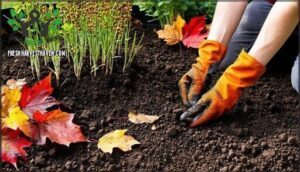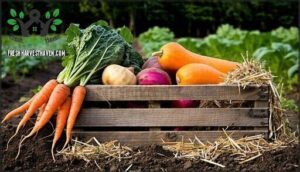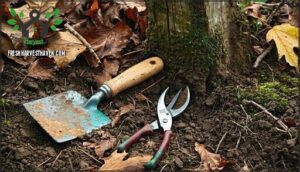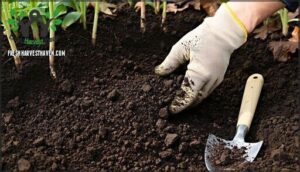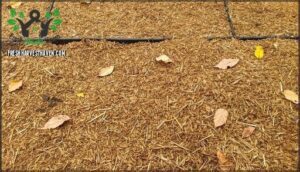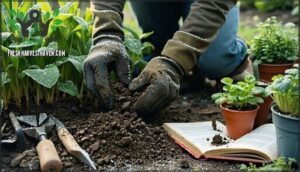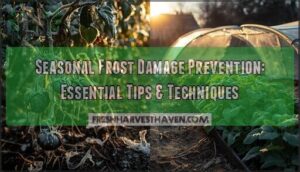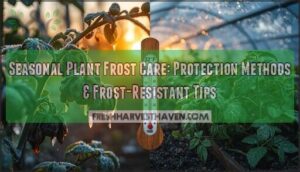This site is supported by our readers. We may earn a commission, at no cost to you, if you purchase through links.
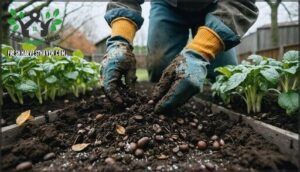 Winter strips topsoil of its protection faster than most gardeners realize. Without the canopy of summer growth, bare soil faces months of rain, wind, and freeze-thaw cycles that compact the structure, leach nutrients, and erode the very foundation of your garden. A single season of neglect can undo years of careful cultivation.
Winter strips topsoil of its protection faster than most gardeners realize. Without the canopy of summer growth, bare soil faces months of rain, wind, and freeze-thaw cycles that compact the structure, leach nutrients, and erode the very foundation of your garden. A single season of neglect can undo years of careful cultivation.
Proper soil preparation during the dormant months doesn’t just prevent damage—it transforms your garden beds into living systems that emerge stronger in spring. By evaluating texture and nutrient levels, clearing debris that harbors disease, and adding amendments that feed beneficial organisms through the cold months, you’re building resilience into the ground itself.
Table Of Contents
- Key Takeaways
- Assessing Your Garden Soil for Winter
- Clearing and Repairing Garden Beds
- Amending and Enriching Soil Before Winter
- Protecting Soil From Winter Damage
- Planning Ahead for Spring Success
- Frequently Asked Questions (FAQs)
- How to build soil over winter?
- How do I prepare my garden for winter?
- How can we improve our garden during the winter?
- What does preparing your garden for winter do for your soil?
- Should you leave soil bare during winter?
- How do you prepare soil for a garden?
- How do you prepare garden soil for winter?
- What should I add to my soil before planting vegetables?
- What month do you start a winter garden?
- Should I fertilize my vegetable garden before winter?
- Conclusion
Key Takeaways
- Bare winter soil faces compaction, nutrient leaching, and erosion that can undo years of careful cultivation, making protective measures like mulch or cover crops essential to preserve soil structure and fertility.
- Testing your soil’s texture, pH, and nutrient levels before winter guides targeted amendments such as compost, lime, or manure that feed beneficial microbes and build resilience during dormant months.
- Winter cover crops like rye and crimson clover prevent erosion while fixing nitrogen and adding organic matter, transforming cold-season beds into living systems that emerge stronger in spring.
- Clearing diseased plant matter, applying two- to four-inch mulch layers, and planning crop rotation during winter protects against pests and pathogens while setting up sustainable growing practices for the next season.
Assessing Your Garden Soil for Winter
Before winter sets in, you need to know what you’re working with. Understanding your soil’s current condition helps you make smart decisions about what it needs.
Let’s look at two key areas that tell you how ready your garden soil is for the cold months ahead.
Identifying Soil Composition and Structure
Understanding your soil’s makeup is the foundation of smart winter prep. You’ll want to know your soil texture, mineral composition, and organic matter levels before making any amendments. A simple soil test reveals pH, nutrient content, and structure. Here’s what to check:
- Soil texture: Use the jar sedimentation method to measure sand, silt, and clay percentages, then consult the soil triangle for classification
- Mineral composition: Identify dominant minerals like quartz and assess how reactive your soil particles are
- Organic matter: Aim for 3–5% organic matter content, which encourages water-stable aggregates and nutrient cycling
- Soil structure: Look for well-formed aggregates that crumble easily, indicating good tilth and drainage
- Water content: Note how quickly your soil drains or retains moisture after recent rain
This baseline snapshot guides every decision you’ll make for winter soil care. Remember that warmer climates affect soil organic matter levels.
Recognizing Signs of Soil Degradation
Your soil tells a story through visible warning signs. Watch for erosion indicators like exposed roots, rills in bare patches, or sediment washing onto pathways after heavy rain. Compaction signs include hard, crusted surfaces that shed water instead of absorbing it, along with stunted plant growth and shallow roots. Salinity effects show up as white crusts on the soil surface and poor germination rates. Nutrient deficiency appears through pale, yellowing leaves and weak stems. Biodiversity loss means fewer earthworms, sluggish decomposition of organic matter, and lifeless, clumpy soil that lacks structure.
Globally, this can lead to extensive land degradation.
A soil test confirms these observations and guides your soil improvement plan before winter sets in.
Clearing and Repairing Garden Beds
Before winter settles in, you’ll need to get your garden beds back in shape. This means clearing out what’s left from the growing season, dealing with crops that are still hanging on, and making sure you haven’t left anything behind.
Let’s walk through each step so your beds are ready for the months ahead.
Removing Debris and Old Plant Matter
After the first frost rolls through, clearing out spent plants and lingering debris becomes your first real step toward healthier spring soil. Here’s what to remove for effective garden cleanup:
- Pull dead annuals and diseased foliage to prevent soil-borne pathogens from overwintering
- Cut back infected perennials for plant disease removal
- Clear fallen leaves harboring pest eggs for pest habitat elimination
- Remove weeds before they drop seeds for weed seed control
- Sort healthy material for your compost pile, discarding diseased matter separately
This soil preparation protects next season’s crops.
Harvesting and Storing Late-Season Crops
Once you’ve cleared away the debris, don’t let those final vegetables go to waste—some crops actually taste better after a light frost, while others need to come in before the cold hits. Frost-tolerant vegetables like kale and carrots can withstand winter harvesting, but tender crops need immediate attention.
Cure harvested crops properly—squash needs weeks of warmth, while root crop storage requires cool, humid conditions. This fall gardening step guarantees your winterization efforts pay off during harvest season.
Inspecting for Abandoned Tools and Equipment
Before you close the garden for the season, take a careful walk through your beds—you’d be surprised how many trowels, pruners, and stakes disappear under piles of leaves or get buried in the soil.
Check your gardening tools for rust and damage, creating an inventory checklist as you go. Clean and oil each item before equipment storage to prevent corrosion.
This garden tool maintenance routine eliminates safety hazards and makes sure your tools are ready when spring arrives.
Amending and Enriching Soil Before Winter
Winter is when your soil does its best work, breaking down nutrients and building structure for spring. The right amendments now mean healthier plants and better harvests later. Here’s what to add before the ground freezes.
Adding Compost and Organic Matter
Think of compost as a winter blanket that feeds your soil while it rests, delivering a slow release of nutrients that’ll be waiting when spring arrives. Spread a two- to three-inch layer of finished compost across your beds in late autumn, allowing decomposition processes and soil microbes to break down organic matter throughout the cold months.
This simple application method improves soil structure and sets the stage for healthier spring growth.
Using Lime, Manure, and Biochar for Balance
Beyond compost, lime application adjusts soil pH for best nutrient uptake, while manure adds nitrogen and phosphorus—though winter spreading increases runoff risks considerably. Biochar benefits include enhanced soil phosphorus retention and reduced leaching, especially when paired with lime for amendment synergy. Before applying these soil amendments, conduct a soil test to guide rates and timing for safe, effective soil preparation.
- Pelletized lime gradually raises pH over 100+ days; plan application in fall or late winter
- Winter manure runoff can quadruple nutrient loss; avoid spreading on frozen ground or snow
- Biochar increases available phosphorus by up to five times in acidic soils
- Combining biochar with lime boosts phosphorus availability by 169–209% compared to single amendments
- Tillage boosts lime effectiveness by moving it into the root zone where plants need it most
Selecting and Sowing Winter Cover Crops
Winter cover crops act like a living blanket, shielding bare soil from erosion while building organic matter and fixing nitrogen for your spring garden. Choose cover crop types based on your timing considerations—winter rye tolerates cold best, while crimson clover fixes nitrogen faster.
Sow six to eight weeks before frost for strong root development, then use termination methods like mowing or tilling in early spring to heighten soil benefits before planting.
Protecting Soil From Winter Damage
Winter weather can be tough on garden soil, but a few protective measures make all the difference. The right strategies shield your soil from erosion, temperature swings, and weed invasion while keeping beneficial organisms safe.
Here’s how to give your garden beds the protection they need until spring arrives.
Applying Mulch and Straw for Insulation
A blanket of mulch or straw over your garden beds works like a warm coat for the soil, locking in moisture and keeping those roots cozy through the coldest months. Apply a two- to four-inch layer of organic mulch types like shredded leaves or straw for proper insulation depth.
This winterizing step protects against temperature swings, discourages weeds, and aids soil care and maintenance while keeping pests from settling in.
Creating Barriers for Erosion and Weed Control
When winter winds blow and heavy rains fall, unprotected soil washes away like sand through your fingers, taking nutrients and topsoil with it. To preserve your hard work and winterizing efforts, set up erosion control barriers.
Here are some effective strategies:
- Cardboard barriers – Layer over beds to smother weeds and prevent soil erosion.
- Plastic sheeting – Anchor edges to block wind and water damage.
- Cover crop roots – Plant to hold soil in place naturally.
- Mulch types – Apply thickly for dual-purpose soil conservation and weed suppression.
These soil care and maintenance strategies keep your garden intact until spring.
Safeguarding Young Plants and Perennials
While barriers shield your soil, your living plants need their own layer of defense to make it through the cold months ahead. Perennials enter winter dormancy naturally, but you can help them survive by mulching around their base for frost protection. Tender plants need covering with burlap or frost cloth when temperatures drop.
Reduce watering needs as growth slows, and hold off on pruning techniques until spring. Check for pest control issues before cold weather protection sets in, since overwintering insects hide in plant debris.
Planning Ahead for Spring Success
Winter’s work sets the stage for spring’s success. Now’s the time to get your garden organized, review what worked this year, and prepare your equipment for the season ahead.
Here’s how to wrap up your winter prep with three essential planning tasks.
Organizing Tools and Gardening Supplies
Once the growing season winds down, your tools and supplies deserve the same care you’ve given your plants all year long. Clean and disinfect all gardening tools with a diluted bleach solution, then organize them in a dry workspace to prevent rust.
Store gardening supplies in labeled containers, separating seeds, fertilizers, and amendments. A clear labeling system saves time come spring, and proper tool storage extends their lifespan considerably.
Reviewing Crop Rotation and Soil Health Strategies
Now’s the time to map out next year’s growing plan. Crop rotation matters—it slashes soil-borne pests by 40–60%, boosts microbial diversity, and locks in nutrient cycling without excess fertilizer. Your soil needs this kind of strategic thinking:
- Rotate plant families to interrupt pest and disease cycles
- Add legume cover crops for natural nitrogen (up to 200 lbs/acre)
- Track what grew where to maintain pest suppression
- Plan for deeper organic matter buildup over multiple seasons
- Balance nutrient demand across crops for yield stability
Healthy rotation equals sustainable gardening practices that pay off long-term.
Cleaning Pots and Preparing for Next Season
Your pots need attention too—caked-on soil and lingering pathogens can sabotage next spring before you even plant a seed. Scrub each container with diluted bleach (1 part to 9 parts water) for pot sanitation, rinse thoroughly, and let them dry completely.
Sort by material—clay, plastic, fabric—for smarter storage solutions. Stack clean pots in a dry space to prevent cracking and guarantee spring readiness when planting season arrives.
Frequently Asked Questions (FAQs)
How to build soil over winter?
Building soil over winter transforms a cold, quiet season into a powerhouse of underground activity. Add compost and organic matter, then sow winter cover crops like rye to feed soil organisms and boost nutrient cycling through natural winter decomposition.
How do I prepare my garden for winter?
Preparing your garden for winter involves garden cleanup, harvesting late-season crops, adding compost, and applying mulch for soil insulation.
Protecting perennials with frost protection, adjusting winter watering schedules, organizing tool storage, and planning crop rotation strategies for spring success are also crucial steps.
How can we improve our garden during the winter?
Dormant beds don’t mean dormant work. You can improve your garden during winter by applying composting materials, testing soil pH and nutrient levels, planning crop rotation strategies, and researching frost protection methods for spring plantings.
What does preparing your garden for winter do for your soil?
Good winter preparation protects soil structure, prevents erosion, suppresses weeds, and maintains microbial activity. Adding compost boosts nutrient retention, while mulch insulates against freezing and thawing cycles that damage soil health.
Should you leave soil bare during winter?
Leaving soil bare is like inviting trouble through an open door. Erosion risk increases, nutrient leaching accelerates, and weed growth explodes come spring. Frost impact disrupts soil structure, while soil microbes suffer without protection.
Bare winter soil invites erosion, nutrient loss, and weed invasion while frost disrupts structure and harms soil microbes
Cover your winter garden with mulch or cover crops to maintain soil health throughout the season.
How do you prepare soil for a garden?
Start by testing your soil’s pH and nutrient levels through your county Extension office, then work in compost, aged manure, or other amendments based on those results.
Guarantee proper drainage by incorporating organic matter, and consider no-till methods to protect soil structure and beneficial organisms.
How do you prepare garden soil for winter?
Before frost strikes, clear debris, harvest crops, and test your soil.
Add compost, organic matter, and cover crops like winter rye to boost soil nutrient retention.
Mulch beds to prevent erosion, regulate temperature, and stop pest hibernation.
What should I add to my soil before planting vegetables?
Before planting vegetables, conduct a soil test to determine nutrient balance and pH. Add compost for organic matter, manure for nitrogen, and lime if acidity needs correction.
These amendments improve soil health, support beneficial microbes, and help your crops get the nutrients they need.
What month do you start a winter garden?
In most regions, fall gardening activities for a winter garden begin in late summer or early fall, usually between July and September.
Hardy vegetable timing depends on your regional climate zones and frost date impact, so count backward from your first expected frost to determine when to plant semi-hardy options for successful winter gardening.
Should I fertilize my vegetable garden before winter?
Fall is a great time to fertilize vegetable gardens with slow-release organic options like compost or aged manure. These amendments address nutrient depletion, improve soil fertility, and support plant needs without harming the environment.
Soil testing helps determine which fertilizer types your winterization plan requires.
Conclusion
What separates a thriving spring garden from one that struggles to recover? The answer lies in soil preparation winter garden practices you complete now, before the ground freezes.
By evaluating texture, clearing debris, adding amendments, and protecting beds with mulch or cover crops, you’re not just maintaining soil—you’re building a foundation that feeds plants, bolsters microbes, and resists erosion through months of harsh weather.
When spring arrives, your beds won’t need rescue. They’ll be ready to grow.
- https://www.nrcs.usda.gov/wps/portal/wcc/home/climateSupport/wetlandsClimateTables/growingSeasonDatesLength
- https://nifa.usda.gov/partners-and-extension-map?state=All&type=Extension
- https://www.instagram.com/p/CWLhCO3LSwZ/
- https://www.soils4teachers.org/files/s4t/texture.pdf
- https://www.sare.org/publications/building-soils-for-better-crops/amount-of-organic-matter-in-soils/

